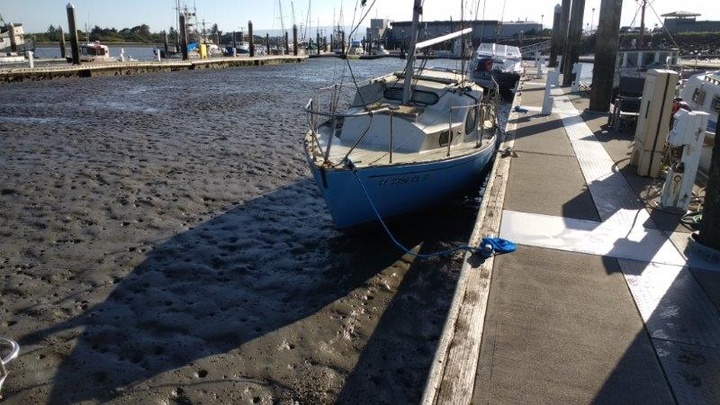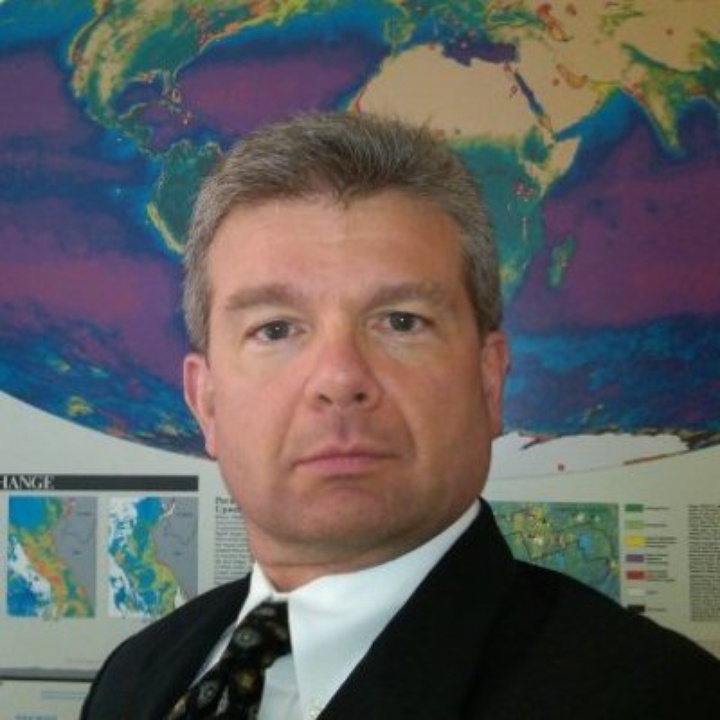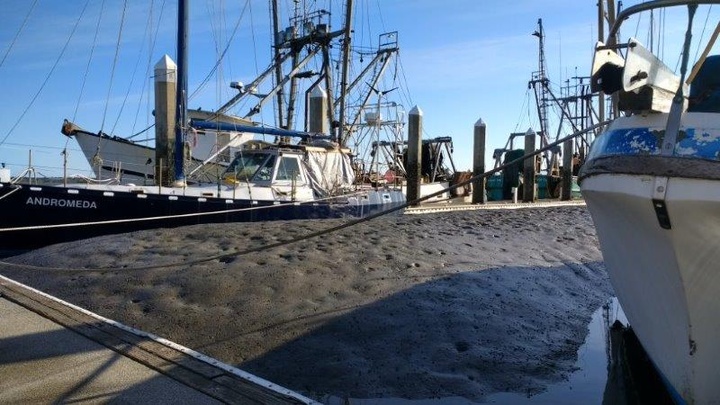
Eureka’s public marina, silted-in at low tide.
PREVIOUSLY:
- CITY OF EUREKA: We Gotta Dredge the Marinas, and Dumping the Spoils on the Beach is The Least Environmentally Impactful Option on the Table
- EPA Rejects Eureka/Harbor District’s Plan to Dump Dredge Spoils on the Beach
- EPA Says Eureka, Harbor District Should Have Known Dredging Disposal on the Beach Wouldn’t be Allowed
It’s a classic strategy: When someone tells you “no,” go ask their boss.
That’s apparently the approach being taken by Humboldt County Supervisor and recently appointed California Coastal Commissioner Ryan Sundberg, who last Monday sent an email to this man:

That’s Jack Bowles, director of state and local relations at the United States Environmental Protection Agency headquarters in Washington, D.C.
In Sundberg’s email — which is posted in full below — he asked Bowles to overrule a decision made earlier this month by EPA officials in the agency’s regional office in San Francisco. Specifically, as we reported earlier this month, the EPA rejected a proposal from the City of Eureka and the Humboldt County Harbor, Recreation and Conservation District to dump dredge spoils from Eureka’s silted-in marinas on a beach along the Samoa Peninsula.
Eureka Parks and Recreation Director Miles Slattery has argued that beach disposal is the least environmentally impactful option available. The materials that get dredged from the Eureka Small Boat Basin Marina and the Woodley Island Marina are 70 percent fine-grain sediment, and Slattery says tests have shown that the nutrient-rich stuff poses no health or environmental concerns.
But Brian Ross, the EPA official in charge of dredged material management at the agency’s Region 9 office in San Francisco, rejected the beach disposal proposal out of hand, noting that regulatory agencies have been telling the Harbor District and the City of Eureka for nearly 20 years to find another disposal method. The EPA’s stance is that the fine-grain silts and mud from the bay are inappropriate for dumping in the surf zone of sandy beaches.
Sundberg takes issue with Ross’s rejection, noting that the EPA and other regulatory agencies allowed beach disposal back in 2006-07. His email also notes the urgent need for dredging. Since the last time the main shipping channels and harbor entrance were dredged, Sundberg writes, “the Army Corps estimates that approximately 3 million cubic yards of sediment has been deposited in the Bay from runoff, rivers and sloughs that discharge into the Bay.”
That’s roughly triple the amount usually deposited between the Corps’ dredging cycles. (Sundberg attached the photos of the marina included in this post.)
Sundberg’s email goes on to lay out a science-based argument for beach disposal, one that closely resembles the case made by Slattery back in March. (It’s perhaps worth noting that the subject line of Sundberg’s email is “FW [forward]: Requested Email.”)
He says the Harbor District and the City of Eureka have a plan for annual maintenance dredging of the marinas, but in order to make that plan feasible the agencies need permission to dump 100,000 cubic yards of dredge spoils on the beach just two more times — once this year and again next year.
Sundberg sent the email to Bowles on the morning of Monday, May 8, but Bowles apparently declined to intervene. Three days later, a spokesperson from the EPA’s Region 9 office responded to Sundberg, informing him that Bowles had kicked the message down to their level “since this is an issue being handled out of the Regional Office in San Francisco.”
The spokesperson said his colleagues “should be following up sometime next week once they have had a chance to consult within our Water Division’s management team.” That team, of course, includes Brian Ross, the man who already rejected beach disposal.
The Outpost sent an email and left a phone message with Sundberg on Tuesday but had not heard back by the time this post was published.
Here’s Sundberg’s email:
From: “Sundberg, Ryan”
Date: May 8, 2017 at 12:16:46 PM EDT
To: “Bowles.Jack@epa.gov
Cc: [redacted]
Subject: FW: Requested EmailHello Jack,
I am forwarding some concerns that I have related to the EPA’s stance on a local dredge maintenance project. The Humboldt Bay Harbor, Recreation and Conservation District (HBHRCD) and the City of Eureka are responsible for the maintenance of our public facilities in Humboldt Bay. The dredge material from maintenance dredging has been deposited on the beach in 1988, 1998 and 2006-07. These projects deposited a range of 130,000-230,000 cubic yards of material on the beach. According to Brian Ross, there was an admonishment given as a part of the Army Corp permit process in 1998 stating that depositing the dredge material on the beach will not be allowed anymore because the EPA classifies the material as waste andll [sic] not be allowed for future dredge maintenance projects. Mr. Ross stated that it was only allowed as a part of the 1998 project because it was considered an emergency. However in 2006-07, an EPA reviewed Army Corps permit was approved for dredge material to once again be deposited on the beach.
The HBHRCD and the City have diligently worked over the past 10 years to finalize a Coastal Regional Sediment Plan in partnership with the Army Corps of Engineers, received multiple grants to research beneficial re-use of dredge material, purchased sampling equipment so that sampling can be done locally and purchased a dredge so that annual maintenance dredging can occur to lessen volumes and associated impacts. This was all accomplished with the goal of eliminating beach disposal of dredged material in the future.
Between the past two episodes of main channel dredging performed by the Army Corps in Humboldt Bay and the entrance, the Army Corps estimates that approximately 3 million cubic yards of sediment has been deposited in the Bay from runoff, rivers and sloughs that discharge into the Bay. Typically between the Corps’ dredging cycles, approximately 1 million cubic yards gets deposited in the bay. This has clearly exacerbated the issues at the public facilities within the Bay. Attached are a couple pictures of Eureka’s marina at a recent low tide.
The HBHRCD and the City have established upland disposal sites that could receive dredge material. However, they cannot hold the volume required to make the two marinas functional. Each marina has approximately 100,000 cubic yards of material that needs to be dredged. All other facilities have much lesser volumes. The two entities have developed a hybrid approach for getting the Bay into an annual maintenance program where this year and next they would like to dispose of 100,000 cubic yards on the beach to get to a level where annual maintenance dredging of the other facilities and the marinas would have less than 30,000 cubic yards and could be disposed of at the upland sites established then beneficially re-used for restoration projects or sea level rise preparedness.
Mr. Ross has informed the two entities that the beach disposal option will not be allowed based on the material being classified as waste. He states that the material has too many fines. The two marinas have been sampled. The constituents of concern concentrations of the material to be dredge at the marinas is magnitudes less than the concentrations of the material in 1988, 1998 and 2006-07 and well below the California Human Health Screening Levels (OEHHA) residential benchmarks. Furthermore, the two entities performed 5 years of annual monitoring of the disposal area for the 2006-07 project. The monitoring determined that the fine material had no significant impact to the area and adjacent areas. The habitat and particle size distribution in the area and adjacent areas returned to pre-dredge conditions within 4 months of the dredging.
There has also been a USGS study performed in Santa Cruz Harbor to research the fate and distribution of fines from dredge material being deposited in the Harbor. The make-up of the material in this study is equivalent to the material at the two Humboldt Bay marinas. The extensive data determined that the project did not result in observable deposition of fine-grained sediment on the beach or inner-continental shelf. It also determined that it resulted in turbidity values significantly lower than those values observed during a large wave event or small flood of the San Lorenzo River. The wave action in the proposed beach disposal area here in Humboldt is much greater than Santa Cruz and the impacts locally would be even less significant than the Santa Cruz project.
The two entities have had a meeting with the other pertinent regulatory agencies. The Coastal Commission had similar concerns about beach disposal expressed in their 2006 Coastal Development Permit. At the meeting, local Commission staff stated that they feel the two entities have demonstrated the ability to discontinue beach disposal through the efforts taken over the past 10 years and could be supportive of the proposed hybrid approach as long as they demonstrate it is the least environmentally damaging alternative.
If they are not able to dispose the large volumes of material from the two marinas on the beach, then dredging the two sites will require at least six different cycles of dredging at the two marinas to get them to a maintenance level. This will significantly increase the habitat impacts at the sites and associated costs. Furthermore, the material will need to be removed from the upland sites for future re-use. This will result in a significant increase in environmental impacts and costs from having to remove the material from the upland sites with 10-20 yard dump trucks. It will take between 10,000 and 20,000 truck trips to remove the material from the upland sites having a huge impact on greenhouse gas emissions.
In summary, I would hope that the EPA could support two years of beach disposal so that the environmental impacts are lessened and the marinas can function safely continuing to provide coastal access and commerce that is so important to Humboldt County. Miles Slattery, City of Eureka Parks and recreation Director, has been working with the regulatory agencies along with the HBHRCD. He would be a good point of contact to discuss this project, and his cell is 707-[xxx-xxxx].
Sincerely,
Ryan Sundberg

CLICK TO MANAGE